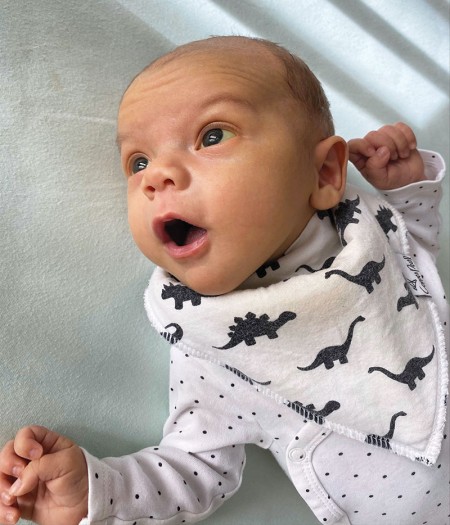Oh Wow! Uh Oh!
Winging it into 2021

Another beautiful grandson, Faires Lord Weber, was delivered into our fold Sept. 29, 2020. As Covid-19 would have it, grandparents weren’t allowed the usual hospital celebration. We were needed anyway to keep track of his 21-month-old brother, Eli, whose two primary expressions, “Oh Wow!” and “Uh Oh,” seem to cover this unfolding story with amazing efficiency.
First came the text from dad Morgan. Faires arrived, at 7:52 a.m., 8 pounds, 9 ounces, safe and sound. Next, a series of pictures of a perfect baby who looks like a giant compared to Eli, born 3 weeks early. Eli and I celebrated that blissful morning at the McGovern Centennial Gardens, soaking in perfect weather and grateful feelings, not far from The Woman’s Hospital of Texas, where Mom, Dad and baby mostly slept.
On Day 2, Oct. 1, we were barely into discussing his hair color, big feet, dagger fingernails and nursing prowess when Morgan’s next text seemed to arrive from another planet. Word groups like “liver not functioning properly” and “not immediately life-threatening” emerged. Then, something about “one of the most world-renowned doctors” in this disease being at Texas Children’s Hospital.
Who needs a world-renowned doctor? I don’t want a world-renowned doctor or anything the need for one implies.
Grandparents group-text words like “God” and “prayers” and “miracles,” while doctors say words like “biliary atresia” and “don’t Google it.” So, of course, we immediately do. It’s very rare – like 1 in 17,000. Yet, most liver transplants performed on infants are a result of this disease. The ducts that transmit bile from the liver are somehow blocked. Something called the “Kasai procedure” can buy some time, to give the child time to grow, but it isn’t a cure. It may work, or it may not. He may need a liver transplant, or he may not.
Rare as it is, Stan’s sister, Mindy Wertheimer, has a friend, Harriet Spain, whose beautiful college-age daughter, Eleanor, was born with the same condition.
Harriet immediately reached out to me. Other words, like “support group,” were added to this list of new words, growing hourly. Harriet sounded supremely wise in her ability to handle me, careful not to divulge more information than I seemed to want to hear. She sounded like a plugged-in pro inside the small community of this rare disease.
She sent a current picture of Eleanor, her daughter born with biliary atresia, standing next to a George Washington University emblem on her bedroom door, which now doubles as her Covid-related college campus. Another picture shows Eleanor with a cute dude, on the beach looking beautiful, normal and happy. She still has her own liver.
It permitted me to entertain a future in my own mind, of Faires, watching his slightly older brother Eli throwing rocks into the Frio at the family place in Leakey, Texas. “Oh wow,” Eli always says, picking up a rock. “Uh-oh,” he says, as it disappears into uncertain streams.
Harriet asked me the name of his gastrointestinal specialist. Sanjiv Harpavat didn’t exactly flow off the tip of my tongue. I had to look it up. “Ohhh! Sonny! I can’t tell you how happy that makes me,” said Harriet.
I noticed that nothing I Googled on this disease mentioned anything about surgery taking place on someone as young as two weeks, like Faires. The stories always began with the infant going home and developing symptoms, then returning to the doctor for the diagnosis, and surgery. By then, liver damage has begun.
Dr. Harpavat, a.k.a. Sonny, and his team discovered that children born with biliary atresia always have a high “conjugated” bilirubin number, in research that started around 2010. Now they routinely screen for this, tracking numbers in the Houston area from 14 hospitals.
The hospital where Faires was born is one of those. Normally it would take about three days for Texas Children’s to receive this information. But, thanks to an alert pediatrician at The Woman’s Hospital of Texas, Dr. Martha Sissa, Dr. Harpavat got the news 24 hours after Faires was born.
Two weeks later, Faires had his Kasai surgery. A piece of his own intestine was attached to his liver, hoping that it serves to conduct the bile out of the liver. Now we wait, 4-6 months, to find out if this works.
What’s not to love about a “world-renowned” doctor who partners with mom on poopie-diaper watch? This isn’t the stream we chose to navigate, but the people in it are total class.
“I got my cuddler,” said mom Julia, of this little boy who is willing to fold into any arms that will hold him. He’s starting to make eye contact and smile in direct response to ours. As these first smiles come in, a little pinprick appears on his bottom right cheek. I think he has my dimple.
UPDATE: Thankfully, the Kasai procedure was successful and Faires is thriving like any other healthy baby. Oh Wow!
Want more buzz like this? Sign up for our Morning Buzz emails.
To leave a comment, please log in or create an account with The Buzz Magazines, Disqus, Facebook, or Twitter. Or you may post as a guest.



